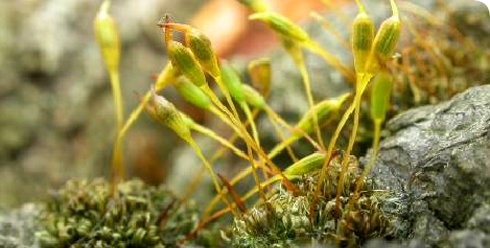Description
Plants
Zygodon forsteri plants are about 1cm tall, blackish green, forming small open cushions of a soft consistency, or loose turfs, often from persistent protonema.
Leaves
erect, to just under 2mm long, somewhat curled and with incurved wispy whitish apices when dry. Broadest above, rather tongue shaped with an acute apex and plain margins. The rounded-hexagonal upper leaf cells are smooth, 14-27µm in diameter, the lower cells are more rectangular-ellipsoidal, increasing in size towards the rather stout nerve which usually ceases just below the apex but may be excurrent in a sharp point.
Gemmae
Unlike the other European Zygodon species propagules are not generally borne on the leaves, but the 4-5 celled cylindrical gemmae can be found in abundance on the protonema. They only have transverse cell walls and are similar to those produced on the leaves of Z. rupestris.
Protonema
The protonema is persistent and quite distinctive, the chloronemal threads forming a blackish slimy film associated with algal species. The caulonemal phase of the protonemal growth bundles more colourless filaments into woven rhizoidal threads, helping to anchor the developing leafy shoots.
Sporophytes
The sporophytes which start to form in late autumn but which mostly expand in late spring have markedly pyriform capsules, c. 1.7mm long, borne on 3-6mm long yellowish-brown setae. Initially bright green, the capsules soon turn yellow and finally yellowish-orange, shrinking to reveal 8 longitudinal ribs. The peristome is double, the 8 pairs of exostome teeth reflexing around the rather contracted capsule mouth when dry. The spores are smooth, 10-13µm in diameter (Calabrese & Muñoz, 2008).
